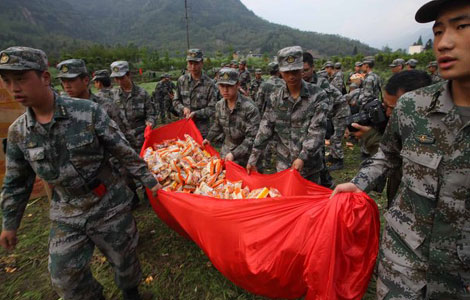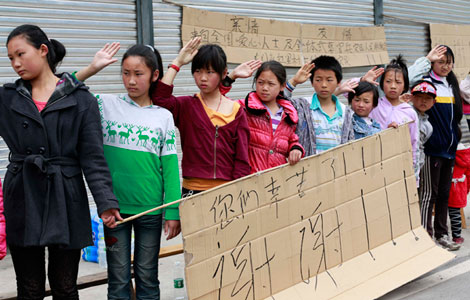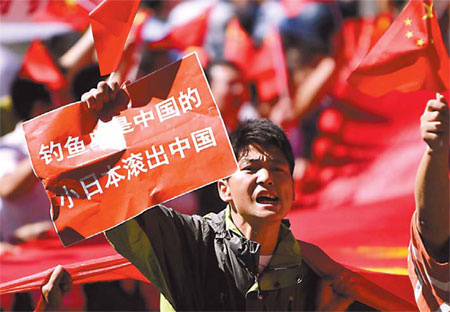Diaoyu Islands cannot be bought
Updated: 2012-09-14 08:03
(China Daily)
|
||||||||
|
A protester, taking part in a demonstration outside the Japanese embassy in Beijing on Thursday, displays a sign stating that "The Diaoyu Islands belong to China, Japan get out of China". Jason Lee / Reuters |
Editor's note: On Tuesday, the People's Daily ran an article explaining the historical background of the Diaoyu Islands. A translation of the article is printed below:
On September 10, 2012, the Japanese government announced its decision to "purchase" Diaoyu Island and its affiliated Nanxiao Island and Beixiao Island under what Tokyo called "nationalization". This move taken by the Japanese government constitutes a serious violation of Chinese territorial sovereignty. The Chinese government and people firmly oppose it and have strongly protested against the move.
1. Diaoyu Islands have been China's inherent territory since ancient times.
1) Diaoyu Islands were first discovered, named and exploited by the Chinese people.
Diaoyu Island and its affiliated islands, including Huangwei Islet, Chiwei Islet, Nanxiao Island and Beixiao Island (hereafter referred to as the Diaoyu Islands) have been an integral part of Chinese territory since ancient times. The book Voyage with a Tail Wind (Shun Feng Xiang Song), which appeared in 1403 (the first year of the reign of Emperor Yongle of the Ming Dynasty), recorded the names of islands that Chinese voyagers passed en route from Fujian to Ryukyu such as "Diaoyu Islet" and "Chikan Islet", known today as Diaoyu Island and Chiwei Islet.
The imperial courts of the Ming and Qing dynasties sent imperial title-conferring envoys to the Ryukyu Kingdom 24 times. Records of the Imperial Title-Conferring Envoys to Ryukyu (Shi Liu Qiu Lu), and voluminous materials left by the envoys, have depicted the topography and geography of the Diaoyu Islands in detail and recorded the demarcation line between China and Ryukyu east of Chiwei Islet. In 1534 (the 13th year of the reign of Emperor Jiajing of the Ming Dynasty), Chen Kan, an imperial title-conferring envoy from the Ming court to Ryukyu, set out in Records of the Imperial Title-Conferring Envoys to Ryukyu China's earliest official record of the maritime boundary between China and Ryukyu: "Diaoyu Islet, Huangmao Islet, Chi Islet, so many islands unfold before my eyes Then Kume Mountain comes into sight; that is where the land of Ryukyu begins. The Ryukyuans on my ship are happy and excited, because they know they have finally returned to their homes." The passage indicates that Ryukyuans believed they had arrived at Ryukyu when they saw Kume Mountain (known as Kumejima Island today) after passing Chiyu Islet (known as Chiwei Yu today). This indicates that the Diaoyu islands belong to China, not Ryukyu.
In 1719 (the 58th year of the reign of Emperor Kangxi of the Qing Dynasty), Xu Baoguang, a deputy title-conferring envoy to Ryukyu, recorded in his book Records of Messages from Chong-shan (Zhong Shan Chuan Xin Lu, Chong-shan is another name of the Ryukyu Kingdom) that the Yaeyama Islands formed the "southwest border of Ryukyu". The voyage from Fujian to Ryukyu, "passed Huaping Islet, Pengjia Mountain, Diaoyu Tai, Huangwei Islet, Chiwei Islet, and reached Naha port via Kume Mountain (a fortified post on the southwest border of Ryukyu) and Machi Island". The "fortified post" here referred to the main island among the islands and islets southwest to Ryukyu. Cheng Shunze (Tei Junsoku), a noted scholar of Ryukyu, gave a similar account in A General Guide (Zhi Nan Guang Yi), which was published earlier than Records of Messages from Chong-shan. These records prove that China and Ryukyu clearly had an identical understanding of the maritime boundaries and jurisdictions over the various islands.
2) Diaoyu Islands were under the jurisdiction of China for centuries.
As early as the 14th century, in the early years of the Ming Dynasty, the Chinese coastal defense generals Zhang He and Wu Zhen patrolled China's southeast coast and drove Japanese pirates to the "Ryukyu Ocean", the Ryukyu Trench. At the time the Diaoyu Islands had become a coastal front line in the battle against Japanese pirates and were under the jurisdiction of China's coastal defense.
In 1561 (the 40th year of the reign of Emperor Jiajing of the Ming Dynasty), An Illustrated Compendium on Maritime Security (Chou Hai Tu Bian) compiled by Hu Zongxian, Supreme Commander of the southeast coastal defense of the Ming court, and the geographer Zheng Ruozeng, included Diaoyu Islands on a "Map of Coastal Mountains and Sands" (Yan Hai Shan Sha Tu) and marked it as under the jurisdiction of the Ming court's coastal defense. The Complete Map of Unified Maritime Territory for Coastal Defense (Qian Kun Yi Tong Hai Fang Quan Tu), drawn up by Xu Bida and others in 1605 (the 33rd year of the reign of Emperor Wanli of the Ming Dynasty), and the Treatise on Military Preparations Coastal Defense II Map of Fujian's Coastal Mountains and Sands ( Wu Bei Zhi Hai Fang Er Fu Jian Yan Hai Shan Sha Tu), drawn up by Mao Yuanyi in 1621 (the first year of the reign of Emperor Tianqi of the Ming Dynasty), also included Diaoyu Islands as part of China's maritime territory. The Qing court followed the Ming court in placing Diaoyu Islands under the Chinese jurisdiction for coastal defense.
In 1556 (the 35th year of the reign of Emperor Jiajing in the Ming Dynasty), Zheng Shungong was dispatched by the Ming court to Japan on a study trip and he wrote A Mirror of Japan (Ri Ben Yi Jian) following the study trip. An illustration in the book - A Mirror of the Seas and Fords (Cang Hai Jin Jing), depicted Diaoyu Islands with a caption saying "Diaoyu Islet is a little islet adjacent to Xiaodong". Xiaodong was another name for Taiwan. This shows that China, at the time, affirmed that Diaoyu Islands were geographically affiliated and connected to Taiwan. Official documents of the Qing Court such as A Tour of Duty in the Taiwan Sea (Tai Hai Shi Zha Lu) and Annals of Taiwan Prefecture (Tai Wan Fu Zhi) have given detailed accounts of the administration on Diaoyu Islands. The Recompiled General Annals of Fujian (Chong Zuan Fu Jian Tong Zhi), issued in 1871, established in no uncertainty that Diaoyu Islands were affiliated to Gamalan, Taiwan (known as Yilan County today).
3) Chinese and foreign maps prove that Diaoyu Islands belong to China since ancient times.
The Roadmap to Ryukyu (Liu Qiu Guo Hai Lu) in the Records of the Imperial Title-conferring Envoys to Ryukyu, complied by imperial title-conferring envoy Xiao Chongye in 1579 (the seventh year of the reign of Emperor Wanli in the Ming Dynasty) and the Atlas of the Great Qing Dynasty (Da Qing Yi Tong Yu Tu) compiled in 1863 (the second year of the reign of Emperor Tongzhi of the Qing Dynasty) have all clearly marked and recorded Diaoyu Islet, Huangwei Islet and Chiwei Islet.
The book Illustrated Outline of the Three Countries (San Guo Tong Lan Tu Shuo) written by the Sendai scholar Hayashi Shihei in 1785 was the earliest Japanese literature to mention Diaoyu Islands. The Map of the Three Provinces and 36 Islands of Ryukyu (Liu Qiu San Sheng Bing San Shi Liu Islands Zhi Tu) in the book depicted Diaoyu Islands in the same color as the mainland of China, indicating that Diaoyu Islands were part of China. A Map of Great Japan, drawn up in 1876 by Japan's General Staff Office of the Ministry of Army, a Complete Map of the Ryukyu Islands attached to New Annals of Ryukyu published in Japan in 1873, a Map of Great Japan with Rectified Prefectures published in 1875, and a map of Okinawa published in the Annals of Okinawa in 1877 all excluded Diaoyu Islands.
Michel Benot, a French Jesuit who arrived in China in 1744, was commissioned by the Qing court to create the Great Universal Geographic Map (Kun Yu Quan Tu) in 1767, which labeled Diaoyu Islands in the coastal waters of China with the words of Minnan dialect (Ban Lam Gu). A New Map of China from the Latest Authorities, published in Britain in 1811, marked Diaoyu Islands as Chinese territory. A Map of China's East Coast: Hong Kong to Gulf of LiaoTung, compiled by the British Navy in 1877, identified Diaoyu Islands as affiliated to Taiwan and clearly separated them from Japan's Nansei Islands. This map was later widely referred to in international exchanges.
Thus it can be seen that China, by the early 1400s at the latest, had discovered Diaoyu Islands and placed them under its jurisdiction as affiliated to Taiwan. The international community, including Japan, had recognized the fact. This shows that Diaoyu Islands were by no means terra nullius. Japan's claim to "sovereignty" over Diaoyu Islands on the ground of the "occupation" principle is nothing but a historical lie and will only serve to expose its motive.
2. Japan's occupation of Diaoyu Islands is illegal and invalid.
1) Japan started to encroach on Diaoyu Islands in the late 19th century.
Immediately after seizing Ryukyu in 1879, Japan began to extend its reach to China's Diaoyu Islands. Tatsushiro Koga, a Japanese explorer, landed on Diaoyu Islands in 1884, claiming that they were terra nullius. Between September and November 1885, the Japanese government secretly dispatched three facts-finding missions to the islands which concluded that, these "terra nullius" islands were, in fact, the same Diaoyu Tai, Huangwei Islet and Chiwei Islet that were recorded in the Records of Messages from Chong-shan and well known to imperial title-conferring envoys of the Qing court on their voyages to Ryukyu.
Between 1885 and 1893, the then authorities in Okinawa Prefecture three times submitted a written request to the Japanese government that Diaoyu Islands, Huangwei Islet and Chiwei Islet be put under its jurisdiction and boundary markers erected. China reacted to this. On September 6, 1885 (July 28 in the 11th year of the reign of Emperor Guangxu of the Qing Dynasty), the Chinese newspaper Shen-pao (Shanghai News) reported: "Recently, Japanese flags have been seen on the islands northeast to Taiwan, revealing Japan's intention to occupy these islands." China's reaction made the Japanese government think twice before taking any further action. The then Japanese Foreign Minister Inoue Kaoru expressed his concern in his letter to Yamagata Aritomo, the Japanese Minister of Internal Affairs, "At present, any open moves such as placing boundary markers are bound to alert the Qing imperial court. Therefore, it is advisable not to go beyond field surveys and detailed reports on the shapes of the bays, land and other resources for future development. In the meantime, we will wait for a better time to engage in such activities as putting up boundary markers and embarking on development on the islands." In light of this, the Japanese government rejected the requests from Okinawa Prefecture. These facts have all been clearly recorded in Japan Diplomatic Documents. All this shows that Japan intended to occupy Diaoyu Islands, knew full well China's sovereignty over the islands, and refrained from acting impetuously only for fear of reaction from China.
2) Japan illegally grabbed Diaoyu Islands through the First Sino-Japanese War.
Japan started the first Sino-Japanese War in July 1894. Towards the end of November 1894, Japanese forces seized the Chinese port of Lushun (then known as Port Arthur), virtually ensuring the defeat of the Qing court. Against this backdrop, the Japanese Minister of Internal Affairs Yasushi Nomura wrote to Foreign Minister Mutsu Munemitsu on December 27 that "I am writing to discuss with you about setting up boundary markers in Kuba-jima (Huangwei Islet) and Uotsuri-jima (Diaoyu Islands)". "The circumstances have now changed and it is possible to submit this issue to the cabinet for a reconsideration." Mutsu Munemitsu expressed his support for the proposal in his reply to Yasushi Nomura on January 11, 1895. The Japanese government secretly passed a resolution on January 14 to place Diaoyu Islands under the jurisdiction of Okinawa Prefecture. But in fact, at the time, the Japanese government neither erected any boundary markers on Diaoyu Islands, nor did it include in the Japanese Emperor's decree on the geographical scope of Okinawa Prefecture. On April 17 the same year, China was forced to sign the unequal Treaty of Shimonoseki with Japan, under which the entire island of Taiwan, together with all its affiliated islands, including Diaoyu Islands, were ceded to Japan. Thereafter, Japan imposed colonial rule over Taiwan and its affiliated Diaoyu Islands for 50 years from the signing of the unequal treaty until Japan's surrender at the end of World War II.
3) Diaoyu Islands were returned to China after World War II.
On December 1, 1943, China, the US and the UK issued the Cairo Declaration, which stated in explicit terms that "all the territories Japan has stolen from the Chinese, such as Manchuria, Formosa (Taiwan) and the Pescadores, shall be restored to the Republic of China. Japan will also be expelled from all other territories which she has taken by violence and greed." In July 1945, China, the US and the UK issued the Potsdam Proclamation (The Soviet Union signed the Proclamation in August that year) which stated in Article 8: "The terms of the Cairo Declaration shall be carried out and Japanese sovereignty shall be limited to the islands of Honshu, Hokkaido, Kyushu, Shikoku and such minor islands as we determine." On August 15, 1945, Japan accepted the Potsdam Proclamation and surrendered unconditionally. On September 2, the Japanese government pledged to faithfully fulfill the obligations enshrined in the provisions of the Potsdam Proclamation in Articles 1 and 6 of the Japanese Instrument of Surrender. These documents all testify to the fact that Taiwan and its affiliated Diaoyu Islands should be simultaneously returned to China.
4) Backroom deals between Japan and the United States over Diaoyu Islands are illegal and invalid.
On September 8, 1951, Japan, the United States and a number of other countries signed the Treaty of Peace with Japan (commonly known as the Treaty of San Francisco) with China excluded from it, which placed the Nansei Islands south of the 29th parallel of north latitude under United Nations' trusteeship, with the United States as the sole administering authority. On September 18, 1951, Zhou Enlai, the then Chinese Premier and Foreign Minister, made a solemn statement on behalf of the Chinese government that the Treaty of Peace with Japan signed in San Francisco was illegal and invalid and could under no circumstances be recognized by the Chinese government since China had been excluded from its preparation, formulation and signing. The islands placed under the administration of the United States in the Treaty of Peace with Japan did not include Diaoyu Islands. However, on December 25, 1953, the United States Civil Administration of the Ryukyu Islands (USCAR) issued Civil Administration Proclamation No. 27 defining the "geographical boundary lines of the Ryukyu Islands", arbitrarily expanding its jurisdiction to include China's Diaoyu Islands. There were no legal grounds whatsoever for the United States to take this action.
On June 17, 1971, Japan and the United States signed the Agreement Concerning the Ryukyu Islands and the Daito Islands (Okinawa Reversion Agreement), which provided that any and all powers of administration over the Ryukyu Islands and Diaoyu Islands would be "reverted" to Japan. The Chinese government and people, including overseas Chinese, expressed their strong opposition to the backroom deal between Japan and the United States over Diaoyu Islands. The Chinese Ministry of Foreign Affairs issued a statement, fiercely condemning the US and Japanese governments for wilfully including China's Diaoyu Islands into the territories to be returned to Japan in the Agreement. The statement pointed out that "the agreement was a blatant violation of Chinese territorial sovereignty and would not be tolerated by the Chinese people."
In face of this, the United States administration had to make clarifications. It publicly stated that "the United States believes that a return of administrative rights over those islands to Japan, from which the rights were received, can in no way prejudice any underlying claims. The United States cannot add to the legal rights Japan possessed before it transferred administration of the islands to us, nor can the United States, by giving back what it received, diminish the rights of other claimants. The United States has made no claim to Diaoyu Islands and considers that any conflicting claims to the islands are a matter for resolution by the parties concerned." In the same year, when presenting the Okinawa Reversion Agreement to the United States Senate for ratification, the United States Department of State stressed that the United States took a neutral position with regard to the competing Japanese and Chinese claims to the islands, despite the return of administrative rights over the islands to Japan. The United States Department of State has since restated its position even in recent years, stating that "the United States does not take a position on the question of the ultimate sovereignty of the Senkaku Diaoyu Islands. This has been our longstanding view. We expect the claimants will resolve this issue through peaceful means."
The facts have shown that both the Japanese stealing of Diaoyu Islands from China in the late 19th century and the backroom deals by the US and Japan concerning Diaoyu Islands in 1970s are acts of grave violation of China's territorial sovereignty. They were illegal and invalid, did not and cannot in any way change China's ownership of Diaoyu Islands.
3. China has taken a strong stance to safeguard its sovereignty over Diaoyu Islands.
During the negotiations between China and Japan on the normalization of their diplomatic relations in 1972 and on the conclusion of the Sino-Japanese Treaty of Peace and Friendship in 1978, the then leaders of the two nations, with the overall interests of bilateral ties in mind, reached an important understanding and consensus to "leaving the issue of the Diaoyu Island to be resolved later". However, the Japanese government has, since the late 1970s, gone back on the commitments and connived at such activities as landing on Diaoyu Islands and building "lighthouses" by right-wingers. In recent years, the Japanese government has become increasingly involved in infringements on Diaoyu Islands. The Japanese government first "rented" Diaoyu Island, Beixiao Island and Nanxiao Island from their "private owners", then "nationalized" the "lighthouses" built by right-wingers, and finally registered some citizens as residents of Diaoyu Islands. Japan has also deposited with the Secretary-General of the United Nations of a chart which marks its "territorial waters" around Diaoyu Islands.
China has forcefully stated its firm opposition to these Japanese infringements. Diplomatically, the Chinese government has made stern representations with the Japanese government and has taken strong countermeasures. Under pressure, the Japanese government made clear that it would "not support, encourage or acknowledge" the actions of right-wingers on Diaoyu Islands, promised to restrain them and prohibit them from landing on the islands. Legally, China has taken a number of measures to reaffirm its sovereignty over Diaoyu Islands. In February 1992, China issued the Law of the People's Repulic of China on the Territorial Sea and the Contiguous Zone, which reiterates China's territorial sovereignty over Diaoyu Islands in the form of legislation. On May 15, 2008, China sent a note to the Secretary-General of United Nations in opposition to Japan's depositing with the United Nations of a chart which marks its "territorial waters" around Diaoyu Islands. On March 3, 2012, China released standard names and descriptions of Diaoyu Island and its affiliated islands. On September 10, 2012, China released territorial baselines of Diaoyu Island and its affiliated islands. In the meantime, Chinese fishery law enforcement vessels conduct routine patrols in the waters around Diaoyu Islands and Chinese maritime surveillance vessels have also patrolled the waters to safeguard and exercise China's sovereignty and jurisdiction over Diaoyu Islands and adjacent waters. All these measures have dealt a severe blow to the Japanese scheme to occupy the islands.
4. Any Japanese attempt to covet Diaoyu Islands is doomed to failure.
Since the beginning of this year, the Japanese government has taken actions one after another over the issue of Diaoyu Islands. Even this year, it staged a farce of naming Diaoyu Island and its affiliated islands. Then it encouraged the right-wingers to instigate a political storm around the issue of "purchasing" the islands. Finally, the Japanese government pulled off its mask and revealed its own intention to "purchase" and "nationalize" Diaoyu Island, Nanxiao Island and Beixiao Island. By "nationalizing" the islands, the Japanese government aims to reinforce its "actual control" over Diaoyu Islands and eventually occupy the islands. Yet, no matter how the Japanese government argues and glosses over its proposal, it cannot hide its true intention of "buying or selling" things that belong to others. Anyone with common sense can see it is absurd, illegal and doomed to failure.
The root cause of Japan's wrong stance on Diaoyu Islands lies in the absence of a correct understanding and profound remorse by some forces in Japan of the crime of militarist aggression that Japan committed in the past. At the heart of the matter is a disregard for, and overturning of, international legal documents, including the Cairo Declaration and the Potsdam Proclamation, which determined the post-war arrangements with Japan and the post-war order in the Asia-Pacific region. This amounts to a denial of, and a challenge to, the victorious result of the world war against fascism. In dealing with neighboring countries, including China, on territorial disputes, Japan has failed to show sincere remorse for its past aggression and colonial rule. Instead, it has revealed its intention to recover the "losses" the defeat in its war of aggression had inflicted on it, and save face by creating friction with neighboring countries.
This year marks the 40th anniversary of the normalization of China-Japan diplomatic relations. Forty years ago, the then leaders of the two countries showed great foresight and political wisdom and overcame many difficulties to resume diplomatic relations between the two countries and put China-Japan relations on the track of normal development. But today some Japanese politicians are going against the trend of the times and damaging the foundations of relations between the two countries, much to the indignation of the people. The current relations between China and Japan have not come about easily. A healthy and stable relationship is not only very important to China, but also vitally important to Japan. We advise the Japanese government to recognize the gravity of the situation, pull back from the precipice, and immediately cease all acts that violate China's territorial sovereignty. The determination of the Chinese government and the Chinese people to defend their territorial sovereignty is firm and unshakable. We have the will and the ability to defend our territorial sovereignty. Any attempt by Japan to covet Diaoyu Islands will end in failure.

 Relief reaches isolated village
Relief reaches isolated village
 Rainfall poses new threats to quake-hit region
Rainfall poses new threats to quake-hit region
 Funerals begin for Boston bombing victims
Funerals begin for Boston bombing victims
 Quake takeaway from China's Air Force
Quake takeaway from China's Air Force
 Obama celebrates young inventors at science fair
Obama celebrates young inventors at science fair
 Earth Day marked around the world
Earth Day marked around the world
 Volunteer team helping students find sense of normalcy
Volunteer team helping students find sense of normalcy
 Ethnic groups quick to join rescue efforts
Ethnic groups quick to join rescue efforts
Most Viewed
Editor's Picks

|

|

|

|

|

|
Today's Top News
Health new priority for quake zone
Xi meets US top military officer
Japan's boats driven out of Diaoyu
China mulls online shopping legislation
Bird flu death toll rises to 22
Putin appoints new ambassador to China
Japanese ships blocked from Diaoyu Islands
Inspired by Guan, more Chinese pick up golf
US Weekly

|

|








